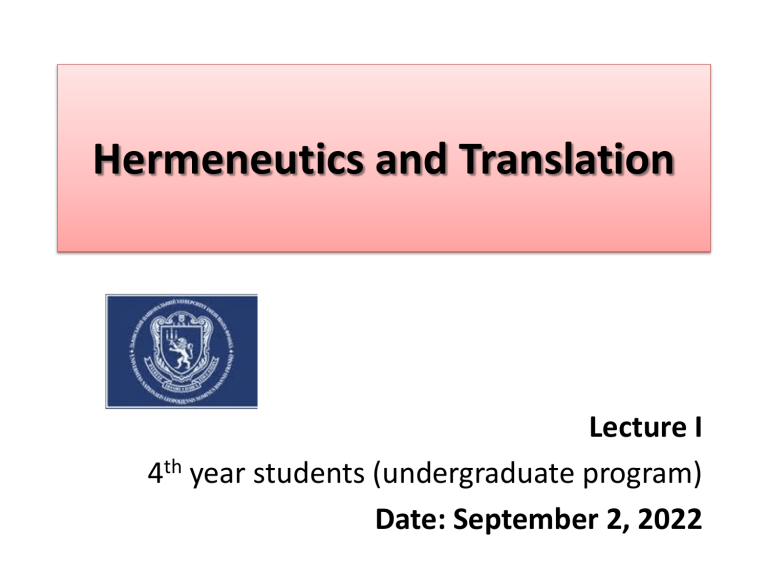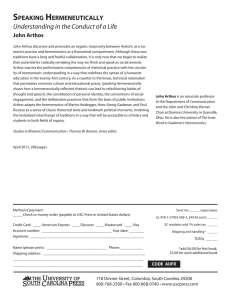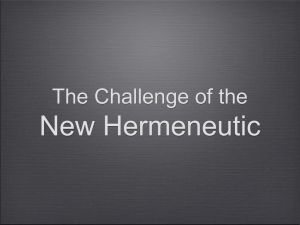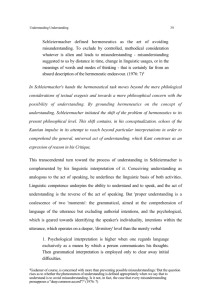
Hermeneutics and Translation Lecture I 4th year students (undergraduate program) Date: September 2, 2022 Hryhoriy Kochur “Переклад – це грандіозний процес, що ніколи не доходить до краю. […] Звичайно, переклад тим і відрізняється від оригіналу, що оригінал – один, він існує в остаточній і незмінній формі, а єдино можливого перекладу не буває, як не буває, скажімо, єдиного виконання музичного твору: кожен виконавець надає своїй інтерпретації власних відтінків, своєрідних рис. Так, власне, і наявність дуже доброго, бездоганного, здавалося б, перекладу не буває межею, що спиняє інших…” Г. Кочур (1966) HERMENEUTICS • derived from the Greek word ἑρμηνεύω (hermeneuō, "translate, interpret"), from ἑρμηνεύς (hermeneus, "translator, interpreter") • Places its origins with HERMES, the mythological Greek god who was “the messenger of gods” and had to master the language of the gods, understand and interpret what these immortal beings have in mind, and translate and articulate their intention to the mortal beings • Hermeneutics was initially applied to the interpretation, or exegesis, of Scriptures (A divine message must be received with implicit uncertainty regarding its truth) HERMENEUTICS • In its barest sense, hermeneutics can be understood as a theory, methodology and praxis of text interpretation • As this working definition suggests, hermeneutics has three different layers of meanings and concerns 1) theory, which is concerned about the epistemological validity and possibility of interpretation; 2) methodology, which is concerned about the formulation of reliable systems of interpretation; 3) praxis, which is concerned about the actual process of interpreting specific texts. Hermeneutics • 1) romanticist hermeneutics, 2) phenomenological hermeneutics, 3) dialectical hermeneutics, 4) critical hermeneutics, and 5) post-structural hermeneutics. • Such categorization of the diverse hermeneutic systems into just five groups is specified by the variations of the structural components of interpretation itself, of which there are three: 1) the interpreter, or the subject; 2) the thing being interpreted, or the object, which is either a text or a text analogue; 3) the goal of the interpretive act, which is either truth or meaning. Friedrich Daniel Ernst Schleiermacher (1768-1834) • Universal hermeneutics; Lecture Ueber die verschiedenen Methoden des Uebersetzens (1813) • Article Genealogies of Translation Theory: Schleiermacher by Lawrence Venuti (1991) • For Schleiermacher, "the genuine translator" is a writer "who wants to bring those two completely separated persons, his author and his reader, truly together, and who would like to bring the latter to an understanding and enjoyment of the former as correct and complete as possible without inviting him to leave the sphere of his mother tongue.“ • A. Berman calls attention to the hermeneutical paradigm introduced here, the emphasis on translation as the object of textual interpretation that enables intersubjective understanding Schleiermacher: HERMENEUTIC CIRCLE One's understanding of the text as a whole is established by reference to the individual parts; one's understanding of each individual part by reference to the whole. Neither the whole text nor any individual part can be understood without reference to one another – it is a circle. Schleiermacher‘s translation concept • Schleiermacher in fact finds only two methods of effecting the target language reader's understanding of the source-language "author": "Either the translator leaves the author in peace, as much as possible, and moves the reader towards him (PARAPHRASE); or he leaves the reader in peace, as much as possible, and moves the author towards him“ (IMITATION) • Schleiermacher privileges the first method! • Schleiermacher intended that the goal of [romanticist] hermeneutics is to capture the original authorial intent Grammatical vs psychological understanding He distinguishes two types of understanding that form the basis of his hermeneutics. (1) grammatical: Human beings learn language and come to understand the meaning of words. (2) psychological: Schleiermacher used a divinatory (дівінаційний, інтуїтивний) method in which one individual is able to get inside the perspective of another individual based upon the common elements of humanity shared by all individuals. Wilhelm Dilthey (1833-1911) • deeply influenced by Schleiermacher but rejects his reliance on intuition and feeling as the mean to access the inner aspects of life and proposes historicality of human life instead. • Human beings live in temporal space and create expressions of their lived experiences. Dilthey understood man as a historical being. • History is not described in terms of an object of the past, but “a series of world views”. • Dilthey wants to emphasize the “intrinsic temporality of all understanding,” that man’s understanding is dependent on past worldviews, interpretations, and a shared world. Romanticist Hermeneutics Martin Heidegger (1889-1976) His major work “Being and Time” (1927): “The Anaximander Fragment” – Early Greek Thinking: raises the question whether the fragment can speak to us after all these years?... by being in tune with the language, a ”bond” which is ”broader and stronger, but far less apparent” Thus, man is the subject of language and disappears in it. Die Sage: Language is the house of Being; true language – Dasein (тут-буття) – world-as-a-text Das Gerede: everyday speech Heidegger: Translation as thought recomposition • For Heidegger, because of the relation between thinking and translating, and the relation of both to language, it is not a thinker's words, but rather the translator's thought, that is translated when he attempts to render a text in his own native language. • The resulting text is a recomposition of the original text, not the exchange of words between the vocabularies of two natural languages. • Translation is viewed as an action, an operation of thought, a translation of our selves into the thought of the other language, and not a linguistic, scientific transfer from sth into the present Heidegger’s hermeneutic circle The ‘hermeneutic circle’ that had been a central idea in previous hermeneutic thinking, and that had been viewed in terms of the interpretative interdependence between the parts of that structure and the whole, was transformed by Heidegger, so that it was now seen as expressing the way in which all understanding was ‘always already’ given over to that which is to be understood (to ‘the things themselves’—‘die Sachen selbst’). Thus, to take a simple example, if we wish to understand some particular artwork, we already need to have some prior understanding of that work (even if only as a set of paint marks on canvas), otherwise it cannot even be seen as something to be understood. To put the point more generally, and in more basic ontological terms, if we are to understand anything at all, we must already find ourselves ‘in’ the world ‘along with’ that which is to be understood. → PHENOMENOLOGICAL HERMENEUTICS Phenomenological Hermeneutics The goal of phenomenological hermeneutics is to capture to truth of the text as it is. Hans-Georg Gadamer (1900-2002) • his magnum opus Truth and Method (1975) • Hermeneutics is not a process in which an interpreter finds a particular meaning, but “a philosophical effort to account for understanding as an ontological—the ontological—process of man.” It is an attempt "to clarify the conditions in which understanding takes place" (Gadamer 1975: 263). • Among these conditions are, crucially, prejudices and fore-meanings in the mind of the interpreter. Gadamer: “principle of effective-history” • Understanding is always interpretation, and it means to use one's own preconceptions so that the meaning of the object can really be made to speak to us. • Understanding is thus not a merely reproductive but a very productive process. • The prejudices and fore-meanings in the mind of the interpreter which make understanding possible, are not at the free disposal of the interpreter, but linked to a 'horizon' and an 'effective history' (Wirkungsgeschichte). "Understanding is not to be thought of so much as an action of one's subjectivity, but as the placing of oneself within a process of tradition, in which past and present are constantly fused." (Gadamer 1975: 258) • develop a 'historical' self-awareness – "historicallyeffected" consciousness; 'principle of effective-history' (1975: 267) … temporal distance is not something that must be overcome. This was, rather, the naive assumption of historicism, namely that we must set ourselves within the spirit of the age, and think with its ideas and its thoughts, not with our own, and thus advance towards historical objectivity. In fact the important thing is to recognise the distance in time as a positive and productive possibility of understanding. It is not a yawning abyss, but is filled with the continuity of custom and tradition, in the light of which all that is handed down presents itself to us." (Gadamer 1975: 264f.) На мій погляд, кожне нове покоління повинно мати свій переклад Вільяма Шекспіра, — вважає Іван Малкович. Адже на кожні два-три покоління з'являються нові мовні шари. Власне Шекспір тому й залишається геніальним, що він завжди сучасний — для кожного часу. І щоб передати особливу актуальність Шекспіра, переклад мусить бути співзвучним з нашим часом. Важливо об'ємно передати його мовне багатство — від ризикованих піверотичних жартів до найвищої прекрасної патетики. Іван Малкович Gadamer: fusion of horizons Horizontverschmelzung • Both the text and the interpreter find themselves within a particular historical tradition, or “horizon.” The horizon: an essential part of the 'hermeneutical situation' which limits our possibility of hermeneutical vision, or understanding. It includes everything that can be seen from a particular vantage point, and nothing more. • “When reading a text it is understood not simply by making sense of the words on the page but by permitting the horizon of the text to fuse with the horizon of the reader in a way that the reader is effected by the text” • “Understanding is always the fusion of horizons” • Gadamer does not argue that for historical understanding, ultimately, we need to place ourselves into the different horizon of a particular historical situation, because this would be an impossible and absurd task. We can neither leave our own horizon, nor would it be desirable, as the effective-history of a continuing tradition depends on constantly new assimilations and interpretations . horizon of language • Linguisticality is the idea that humanity is limited within the horizon of language. Language sits at the core of Gadamer’s hermeneutic. • Human beings cannot understand the world without the use of language, and yet, language itself is limited. • One must always think in a language, even if one does not always have to think in the same language. Hermeneutics cannot evade claiming universality because language as linguisticality— Sprachlichkeit—constitutes a human capacity inseparably linked with rationality as such. exemplifying • An anecdote told by Steven Kemper (1991: 136) may exemplify what Gadamer means: "..restoring sacred places created a 'fusion of horizons' in quite a literal sense. I began to think about this fusion after visiting a relic mound with a Sinhala friend. When I asked him whether the place was ancient, he said 'Yes, it was restored just last year'.“ • “Tristan and Isolde” in the Ukrainian interpretation by V. Koptilov Трістан та Ізольда: переспів-реконструкція "Поставивши собі завдання відтворити українською мовою найдавніші давньофранцузькі поетичні варіанти легенди, сучасний перекладач натрапляє на серйозні труднощі. По-перше, всі тексти фрагментарні, по-друге, вони різностильні. Отже, перекладач має вибирати між близьким до тексту першотвору відображенням уривків назавжди втраченого поетичного цілого (але такий переклад може придатися хіба що фахівцям із зарубіжної літератури) і реконструкцією змісту й стилю цього поетичного цілого, що може зацікавити вже не лише фахівців, а, сказати б, і звичайних читачів. Саме другий шлях і обрав автор цих рядків“ В. Коптілов Dialectal hermeneutics: not interested in capturing a single and unified meaning, but instead in an existential meaning, the meaning of the here and now. Umberto Eco: on interpretation • Eco founded and developed one of the most important approaches in contemporary semiotics, usually referred to as interpretative semiotics. • One of the main books in which he elaborates his theory are The Role of the Reader (1979), Semiotics and Philosophy of Language (1984), The Limits of Interpretation (1990). • Interpretation and Overinterpretation concept is based on the 1990 Tanner Lectures delivered at Clare Hall, Cambridge. Three dimensions of intention • In the course of his three lectures, Eco expounds on his contention that between the - intention of the author (very difficult to find out and frequently irrelevant for the interpretation of a text) ---- intention of the interpreter who (to quote Richard Rorty) simply “beats the text into a shape which will serve for his purpose” there is a third possibility. There is an intention of the text. • The leading strands of contemporary critical thought “…appear to license the reader to produce a limitless, uncheckable flow of ‘readings.’” • What provides a limit, says Eco, is neither the author nor the interpreter, but the text itself. Eco’s overinterpretation: model reader and empirical author • If the number of possible meanings is endless, and endlessly acceptable (Eco’s definition of “overinterpretation”), the notion of communal norms on which to base reasonable interpretations and reject absurd interpretations collapses. For the modern reader, says Eco, every line of text is under suspicion; “the glory of the reader is to discover that texts can say everything, except what their author wanted them to mean.…” • Eco argues that overinterpretation of a text can be recognized even if one does not believe there is only one correct understanding of that text. • The intent of a given text, he says, is to produce what he calls the “model reader.” This model reader takes the appropriate cues from the text so that, even if multiple interpretations are produced, certain overinterpretations are discarded as preposterous. Just how the text and reader are related involves reference to the so-called “hermeneutic circle”. Paul Ricouer (1913-2005): On Translation (2004) • Translation has been a central feature of his philosophy, though it was not until his later years that he made it an explicit theme of his work. • In On Translation (French, 2004; English 2006) he outlines two paradigms: (1) the linguistic paradigm, i.e. how words relate to meanings within the language and between the languages (double duty) (2) the ontological paradigm, i.e. how translation occurs between one human self and the another (- translating oneself to the Other; - partiality; - translator as a middleman “working through” two masters; - crucial openness to the other) • A good translation is when one language discovers itself in and as another! LINGUISTIC HOSPITALITY Translation as a hermeneutic model • His essay “The Paradigm of Translation”: → translation as a model of hermeneutics Translation entails an exposure to strangeness. We are dealing with both an alterity residing outside the home language and alterity residing within it. • “It is always possible to say the same thing in a different way. Now, to say sth in other terms is exactly what a translator does from one language to the other. The inputs at two ends, the two halves of the problem clarify each other and present the richness of the relationship with the Other” • There is no self-understanding; We are an engaged self that traverse the field of foreignness and return to ourselves again, altered and enlarged, “othered” (J.Joyce). • Discovery of the other within the depth of the self. • Five ethical functions of translation: ethic of hospitality, ethic of narrative flexibility, narrative plurality, transfiguring of the past, pardon. Post-structural hermeneutics George Steiner: “After Babel” (1975) The hermeneutic motion, the act of elicitation and appropriative transfer of meaning, is fourfold. (1) initiative trust, an investment of belief (2) aggression as the second move of the translator which is incursive and extractive; an active intention of taking sth away, i.e. the input text (3) incorporation, the import with appropriation and assimilation (4) restitution, making the translation balanced (of forces from SL-TL), and integral; an ethical process. HERMENEUTICAL TRANSLATION COMPETENCE Elements of a hermeneutical translation competence include • the readiness for self-critical reflection • the openness for constant learning • the ability to integrate new cognitive input • the courage for linguistic creativity • an empathetic identification with the message (Stolze 2012: 30) Conclusions … • Hermeneutics as theory, methodology and praxis of text interpretation (from exegesis to universality) • Schleiermacher & Dilthey: authorial intent & hermeneutic circle • Heidegger: language as being; (tradition of phenomenology from Husserl) • Gadamer: horizon and effective-history principle • Umberto Eco: intentions, overinterpretation, model reader • George Steiner: hermeneutic motion • Hermeneutical translation competence • Victor Koptilov: phases of interpretation Thank you for attention!





